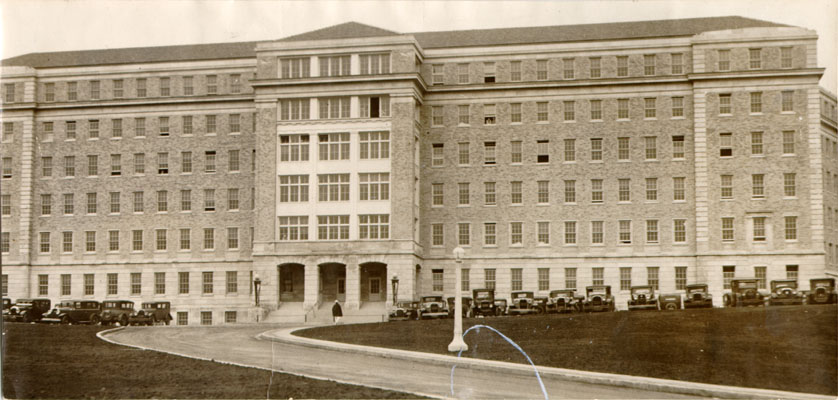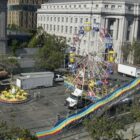One the oldest settlements in the Bay Area, the Presidio, will open a green chapter in its storied existence this weekend when it invites the public to explore the restored, and in many cases sustainably upgraded, historic Public Health Service District.
The abandoned Marine Hospital and a handful of residences in the 42-acre district, located at 15th Avenue and Lake Street on the southern edge of the Presidio, have been converted into a soon-to-be Leadership in Energy and Environmental Design (LEED) certified residential neighborhood after decades of debate over the district’s future.
The district now contains roughly 170 new rentals units, the lion’s share of which are in the converted Marine Hospital. A row of tony new townhomes stand along Belles Street and 11 former physician residences on Wyman Avenue have also been restored. On Saturday, The Presidio Trust will host a day of music, art, food and a chance to roam the renovated buildings and grounds, which have been off-limits to the public for decades.
A Presidio Trust spokesman said the organization, which is charged with managing the Presidio, is proud of its efforts to green the historic building, a challenge that many have shied from. Even seemingly simple improvements, such as adding solar panels to the roof, become insurmountable when heeding historic restoration guidelines.
“Until recently people thought sustainability was incompatible with historic buildings,” said Clay Harrell, a media spokesman for the trust. “We’ve shown that it’s not a waste of time.”
The first historic green neighborhood
The district hopes to become the first historic landmark district in the country to attain a LEED Neighborhood Development certification. Neighborhood Developments are a relatively new addition to the U.S. Green Building Council’s roster of sustainable building stamps of approval. A neighborhood rating includes proximity to basic services and access to public transportation.
The Marine Hospital, a hulking six story, 220,000-square foot Georgian revival styled building, is the largest historic structure in the Presidio. To improve the building’s energy efficiency, insulation was added and weatherstripping applied to the windows. Energy efficient light fixtures were also installed.
The apartments use only low or no volatile organic compounds paints, carpets and adhesives, and word is that the grounds will be maintained using integrated pest management techniques.
Also, a portion of the construction materials come from recycled materials, and there was an effort to recycle 80 percent of the construction waste.
According to Forest City Enterprises, a national real estate company contracted by the trust to restore and develop the district, the green renovations of the Marine Hospital are equivalent to taking 154 cars off the road annually in terms of greenhouse gas emissions reductions. They hope the hospital will achieve LEED gold certification.
For the seven brand new townhomes built on Belles Street, Forest City is aiming for LEED Platinum certification. The heating, plumbing and electrical systems and appliances at restored Wyman Avenue residences have been upgraded to energy efficient systems.
District landscaping includes drought resistant plants and a rainwater capture system that will help cut down on run-off and supply irrigation. Streetlights are kept low and to a minimum number in keeping with national efforts to increase the visibility of the night sky.
Green living in Presidio, however, does not come cheap. A junior one-bed room in the Marine Hospital costs $2,125 a month and a two bedroom can reach as high as $5,800. The townhomes and restored houses begin at around $8,000 a month. And a parking space costs extra.
From public health care to green architecture
The newly greened buildings were once a symbol of another civic issue near and dear to Bay Area residences hearts: public heath care.
In its heyday during the 50s, the Marine Hospital was the largest federal hospital on the West Coast. And by the late 1970s it contained 730 hospital beds and its own helipad.
The concept of Public Health Service hospitals dates back to 1798 when they were established near important port cities by the U.S. Department of Treasury to care for U.S. Merchant Marines. The nationwide group of hospitals went on to conduct leading medical research and serve other members of the military, immigrants and those suffering from epidemic diseases.
In fact, the U.S. Public Health Service in San Francisco is credited as the birthplace of epidemiology. The Presidio’s Marine Hospital, at first a wooden structure built in 1875, was greatly enlarged to accommodate such research in 1932, looking very similar to how it does today.
All Public Health Service hospitals were shut down by 1981, and the Presidio’s hospital sat closed and neglected for almost 30 years while the U.S. Army and then the National Park Service struggled to settle on what to do with it.
At one point there were hopes of it becoming an AIDS hospital, and at another time a youth job training center. It wasn’t until 2004 that The Presidio Trust entered into an exclusive negotiating contract with Forest City Enterprises to develop the district into residences.
This story was co-published with Way Out West, a Bay Area environmental news website.








